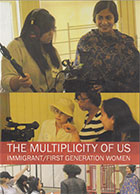
The Multiplicity of Us: Immigrant/First Generation Women 2015
Distributed by Third World Newsreel, 545 Eighth Avenue, Suite 550, New York, NY 10018; 212-947-9277
Produced by New York Women in Film and TV
DVD, color, 15 min.
High School - General Adult
Women’s Rights, Documentaries, Immigration
Date Entered: 02/03/2017
Reviewed by Brandon West, Social Sciences Librarian, State University of New York at GeneseoThis short-form documentary was developed by twenty-four immigrant and first generation women during a video production workshop in New York City. The film is comprised of three stories that expose the ways in which immigrants face adversity due to their identities. Even though the documentary was created by novice filmmakers, the overall message is powerful enough to override any flaws in technical quality by humanizing a highly debated and misunderstood issue in the United States.
Each story was filmed by different groups of women and range between four to five minutes in length. The first story, Coming and Living in America, focuses on the experiences of eight women who have emigrated to the U.S. from countries such as India, Turkey, Venezuela, Ireland, and Indonesia. The women discuss the challenges they have faced in the process of assimilating to life in the United States, including overcoming stereotypes. The second story, Borders: Inside and Out recounts the experiences of a young Mexican immigrant, who has been separated by her family for most of her life, and an elderly women who is the child of Jewish immigrants. The women share the difficulties they have had to face in their respective situations. Finally, Luna’s Story: The Importance of Accepting Yourself details what’s it’s like being a multiethnic women in a society that has a narrow view of race. The women’s first-hand accounts are compelling and often leave the viewer wanting to learn more.
The main issue with this film is that it lacks depth. It introduces powerful narratives and interesting ideas, but only at a surface level. This is mostly due to the film’s short runtime and the inexperience of the filmmakers. For example, the story Coming and Living in America does not have a clear focus as eight different women offer insights within five minutes. While the film is worth watching, it will have limited usefulness in the classroom given how much stories leave to be inferred by the viewer. At best, it could be used as a conversation starter for courses dealing with social issues, immigration, or diversity. Librarians should be aware that this film makes for good supplementary material, but is not as substantive as other documentaries about immigration.